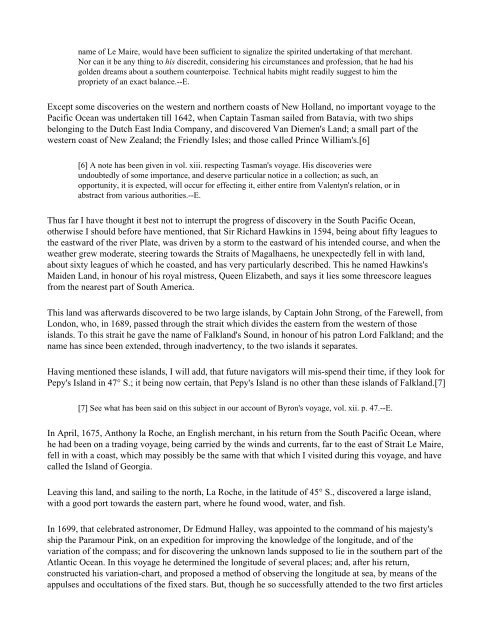A General History & Collection of Voyages and Travels ... - Nauticus
A General History & Collection of Voyages and Travels ... - Nauticus
A General History & Collection of Voyages and Travels ... - Nauticus
Create successful ePaper yourself
Turn your PDF publications into a flip-book with our unique Google optimized e-Paper software.
name <strong>of</strong> Le Maire, would have been sufficient to signalize the spirited undertaking <strong>of</strong> that merchant.Nor can it be any thing to his discredit, considering his circumstances <strong>and</strong> pr<strong>of</strong>ession, that he had hisgolden dreams about a southern counterpoise. Technical habits might readily suggest to him thepropriety <strong>of</strong> an exact balance.--E.Except some discoveries on the western <strong>and</strong> northern coasts <strong>of</strong> New Holl<strong>and</strong>, no important voyage to thePacific Ocean was undertaken till 1642, when Captain Tasman sailed from Batavia, with two shipsbelonging to the Dutch East India Company, <strong>and</strong> discovered Van Diemen's L<strong>and</strong>; a small part <strong>of</strong> thewestern coast <strong>of</strong> New Zeal<strong>and</strong>; the Friendly Isles; <strong>and</strong> those called Prince William's.[6][6] A note has been given in vol. xiii. respecting Tasman's voyage. His discoveries wereundoubtedly <strong>of</strong> some importance, <strong>and</strong> deserve particular notice in a collection; as such, anopportunity, it is expected, will occur for effecting it, either entire from Valentyn's relation, or inabstract from various authorities.--E.Thus far I have thought it best not to interrupt the progress <strong>of</strong> discovery in the South Pacific Ocean,otherwise I should before have mentioned, that Sir Richard Hawkins in 1594, being about fifty leagues tothe eastward <strong>of</strong> the river Plate, was driven by a storm to the eastward <strong>of</strong> his intended course, <strong>and</strong> when theweather grew moderate, steering towards the Straits <strong>of</strong> Magalhaens, he unexpectedly fell in with l<strong>and</strong>,about sixty leagues <strong>of</strong> which he coasted, <strong>and</strong> has very particularly described. This he named Hawkins'sMaiden L<strong>and</strong>, in honour <strong>of</strong> his royal mistress, Queen Elizabeth, <strong>and</strong> says it lies some threescore leaguesfrom the nearest part <strong>of</strong> South America.This l<strong>and</strong> was afterwards discovered to be two large isl<strong>and</strong>s, by Captain John Strong, <strong>of</strong> the Farewell, fromLondon, who, in 1689, passed through the strait which divides the eastern from the western <strong>of</strong> thoseisl<strong>and</strong>s. To this strait he gave the name <strong>of</strong> Falkl<strong>and</strong>'s Sound, in honour <strong>of</strong> his patron Lord Falkl<strong>and</strong>; <strong>and</strong> thename has since been extended, through inadvertency, to the two isl<strong>and</strong>s it separates.Having mentioned these isl<strong>and</strong>s, I will add, that future navigators will mis-spend their time, if they look forPepy's Isl<strong>and</strong> in 47° S.; it being now certain, that Pepy's Isl<strong>and</strong> is no other than these isl<strong>and</strong>s <strong>of</strong> Falkl<strong>and</strong>.[7][7] See what has been said on this subject in our account <strong>of</strong> Byron's voyage, vol. xii. p. 47.--E.In April, 1675, Anthony la Roche, an English merchant, in his return from the South Pacific Ocean, wherehe had been on a trading voyage, being carried by the winds <strong>and</strong> currents, far to the east <strong>of</strong> Strait Le Maire,fell in with a coast, which may possibly be the same with that which I visited during this voyage, <strong>and</strong> havecalled the Isl<strong>and</strong> <strong>of</strong> Georgia.Leaving this l<strong>and</strong>, <strong>and</strong> sailing to the north, La Roche, in the latitude <strong>of</strong> 45° S., discovered a large isl<strong>and</strong>,with a good port towards the eastern part, where he found wood, water, <strong>and</strong> fish.In 1699, that celebrated astronomer, Dr Edmund Halley, was appointed to the comm<strong>and</strong> <strong>of</strong> his majesty'sship the Paramour Pink, on an expedition for improving the knowledge <strong>of</strong> the longitude, <strong>and</strong> <strong>of</strong> thevariation <strong>of</strong> the compass; <strong>and</strong> for discovering the unknown l<strong>and</strong>s supposed to lie in the southern part <strong>of</strong> theAtlantic Ocean. In this voyage he determined the longitude <strong>of</strong> several places; <strong>and</strong>, after his return,constructed his variation-chart, <strong>and</strong> proposed a method <strong>of</strong> observing the longitude at sea, by means <strong>of</strong> theappulses <strong>and</strong> occultations <strong>of</strong> the fixed stars. But, though he so successfully attended to the two first articles


